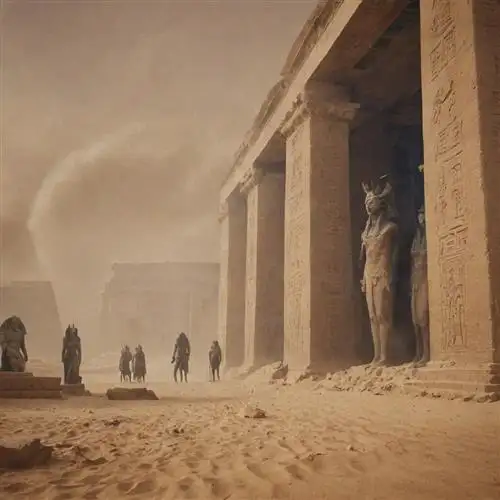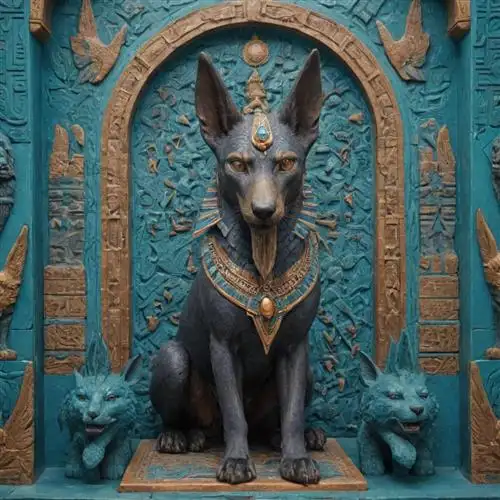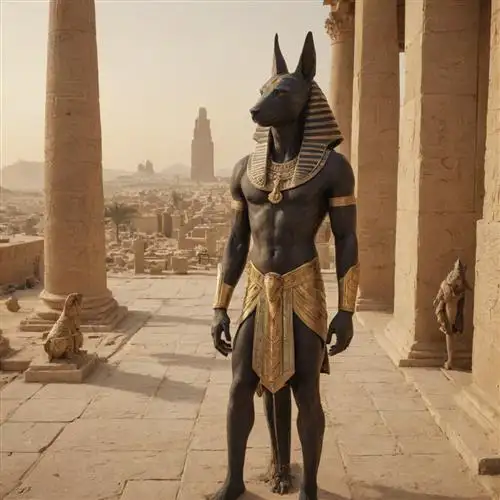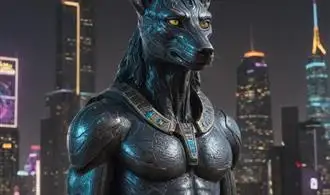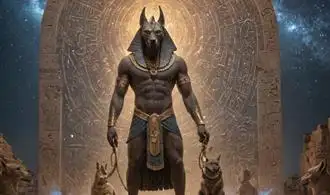
Exploring the Origins of Anubis Iconography
Anubis, the ancient Egyptian god with the head of a jackal, is a figure steeped in rich symbolism and iconography that has captivated scholars and enthusiasts alike. To truly understand the depth and significance of Anubis iconography, we must delve into the origins and evolution of this captivating deity.
The roots of Anubis iconography can be traced back to the Pre-Dynastic period in Egypt, where the jackal-headed figure was associated with the process of mummification and the transition from life to the afterlife. As one of the earliest Egyptian deities, Anubis played a crucial role in the funerary rituals and beliefs of the ancient Egyptians, guiding the deceased through the perilous journey to the afterlife.
The iconic representation of Anubis, with his distinctive jackal-like head, is believed to have emerged from the ancient Egyptians' observation of the jackal's tendency to frequent cemeteries and gravesites. This natural association with the dead and the process of decay led to the jackal-headed figure becoming a symbol of protection and guidance for the deceased.
Over time, the iconography of Anubis evolved to reflect his multifaceted role in the Egyptian pantheon. In addition to his connection with mummification and the afterlife, Anubis was also revered as a deity of embalming, the guardian of cemeteries, and the protector of the dead. These various aspects of his divinity were often depicted through the use of specific symbols and attributes in Anubis iconography.
One of the most recognizable symbols associated with Anubis is the Anubis symbol, which features the jackal-headed figure standing upright, often holding a was scepter or other funerary objects. This image, which can be found on tomb walls, funerary objects, and religious artifacts, serves as a powerful representation of Anubis' role in the afterlife and the process of transition from the mortal realm to the divine.
Alongside the Anubis symbol, other iconic elements of Anubis iconography include the color black, which was associated with the process of mummification and the regenerative powers of the afterlife, and the anubis jackal, which was often depicted in a more naturalistic form to represent the physical embodiment of the deity.
The Symbolic Meaning of Anubis Imagery
Anubis, the ancient Egyptian jackal-headed deity, holds a profound and multifaceted symbolism within the rich tapestry of Egyptian mythology. As the god associated with mummification, the afterlife, and the protection of the dead, Anubis' iconography is imbued with layers of meaning that offer insight into the beliefs and practices of this ancient civilization.
At the core of Anubis' symbolic significance is his role as the gatekeeper to the underworld. As the guide and protector of the deceased, Anubis was responsible for overseeing the delicate process of mummification, ensuring the safe passage of the soul to the afterlife. The jackal-headed form of Anubis is believed to have been chosen for its association with the wilderness and the liminal spaces between the realms of the living and the dead.
The black color of Anubis' skin is also deeply symbolic, representing both the fertile black soil of the Nile River and the decomposition of the body. This dual nature speaks to Anubis' role as a deity of both life and death, embodying the cyclical nature of existence. The color black was also associated with the regenerative power of the underworld, signifying the potential for rebirth and transformation.
Anubis' iconography often depicts him in a seated or standing position, holding a was-scepter (a symbol of power and dominion) or a measuring tool, such as a cubit rod or a set of scales. These objects represent Anubis' role as the judge and overseer of the deceased, responsible for weighing the heart of the dead against the feather of Ma'at (the goddess of truth and justice) to determine the worthiness of the soul for the afterlife.
Deciphering the Artistic Styles of Anubis Depictions
Anubis, the jackal-headed deity of ancient Egyptian mythology, has been a subject of fascination for centuries. Understanding the vast array of artistic styles in which this iconic figure is portrayed can provide valuable insights into the cultural and symbolic significance of this revered deity. From the grand, imposing statues found in temples to the intricate details of funerary artifacts, each Anubis depiction carries a unique story to unravel.
One of the most striking aspects of Anubis iconography is the diversity of artistic styles employed in its representation. In the realm of monumental sculpture, Anubis is often depicted with a powerful, commanding presence, his jackal-like features conveying a sense of strength and authority. These larger-than-life statues, typically found in temple settings, were designed to awe and inspire worshippers, serving as a physical embodiment of Anubis's divine role as the guardian of the dead.
In contrast, the depictions of Anubis found on funerary objects and tomb decorations often exhibit a more delicate and intricate approach. The god's image may be rendered in relief carvings, intricate paintings, or even as miniature figurines placed within the tomb. These representations tend to emphasize the more nuanced aspects of Anubis's character, such as his role as the facilitator of the deceased's transition to the afterlife. The attention to detail and the careful craftsmanship of these smaller-scale works reflect the reverence and significance placed on Anubis in the Egyptian funerary tradition.
Another captivating aspect of Anubis iconography is the integration of the deity's image within broader artistic compositions. In temple wall reliefs and tomb paintings, Anubis is often depicted alongside other deities, forming intricate narrative scenes that convey the complex web of mythological beliefs and rituals. The positioning and interactions of Anubis with these other figures can provide valuable insights into the deity's symbolic relationships and the hierarchical structure of the Egyptian pantheon.
Furthermore, the evolution of Anubis's artistic representation over time can shed light on the changing cultural and religious attitudes toward the deity. Early depictions may emphasize the more primal, animalistic aspects of Anubis, while later renditions may reflect a growing anthropomorphization and increasing complexity in the god's symbolic significance. Tracing these stylistic and iconographic shifts can illuminate the dynamic nature of Anubis's role within the Egyptian belief system and the ongoing process of cultural adaptation and reinterpretation.
The Evolving Role of Anubis in Egyptian Culture
Anubis, the jackal-headed deity, held a pivotal position in the pantheon of ancient Egyptian gods. As the god of embalming and the afterlife, Anubis' iconography and significance evolved over the millennia, reflecting the changing religious and cultural landscape of Egypt.
In the earliest periods of Egyptian history, Anubis was closely associated with the mummification process, responsible for guiding the dead through the treacherous journey to the afterlife. His jackal-like appearance was believed to symbolize his role as the protector of the dead, as the jackal was often seen scavenging in the desert near burial sites. This early association with the necropolis and the embalming process solidified Anubis' status as a crucial figure in the Egyptian funerary cult.
As Egyptian religion and beliefs developed, Anubis' role expanded to encompass a broader range of responsibilities. He became closely linked with the judgment of the dead, where he would weigh the heart of the deceased against the feather of Ma'at, the goddess of truth and justice. This role as the guardian of the underworld and the judge of the dead further cemented Anubis' importance in the Egyptian afterlife theology.
Interestingly, Anubis' iconography also evolved over time, reflecting the changing cultural and artistic trends in ancient Egypt. While the jackal-headed representation remained the most common, Anubis was also depicted as a fully jackal-like creature, a human figure with a jackal head, or even a mummiform figure with the jackal head. These diverse artistic interpretations highlight the adaptability and enduring significance of Anubis in Egyptian art and mythology.
Moreover, Anubis' cult became widespread throughout Egypt, with major temples and shrines dedicated to his worship. These sacred sites not only served as centers of religious activity but also as hubs of cultural and intellectual exchange, where the faithful could seek guidance and the learned could study the mysteries of the afterlife.
Interpreting the Symbolic Gestures of Anubis Iconography
Anubis, the jackal-headed deity of ancient Egyptian mythology, is renowned for his symbolic and intricate iconography. Understanding the gestures and poses associated with Anubis can provide profound insights into the role he played in the ancient Egyptian pantheon and the cosmological beliefs of the time. This knowledge can deepen one's appreciation for the rich symbolism and nuanced meaning conveyed through Anubis' visual representations.
One of the most recognizable gestures of Anubis is the "embalming" pose, where the deity is depicted kneeling beside a deceased individual, his hands placed in a specific manner. This gesture symbolizes Anubis' role as the guardian of the dead, responsible for overseeing the mummification process and ensuring the safe passage of the deceased into the afterlife. The placement of Anubis' hands, often with one hand resting on the deceased's chest and the other extending outward, represents the meticulous care and attention he bestows upon the deceased, guiding them through the intricate rituals of the embalming process.
Another significant gesture associated with Anubis is the "weighing of the heart" ceremony, where the deity is shown standing beside a scale, holding the balance that determines the fate of the deceased's soul. This iconography symbolizes Anubis' role as the judge of the dead, responsible for weighing the individual's heart against the feather of Ma'at, the goddess of truth and justice. The outcome of this weighing process would determine whether the individual's soul was deemed worthy to proceed to the afterlife or be condemned to eternal damnation.
Anubis is also frequently depicted in a standing or seated position, holding various ritual objects or emblems. These visual representations often convey the deity's authority and divine status within the Egyptian pantheon. For instance, Anubis may be shown holding a crook and flail, symbols of kingship and divine power, or a sacred ewer, which was used in purification rituals. The specific objects or gestures associated with Anubis in these static depictions can provide insights into his multifaceted responsibilities and the reverence with which he was viewed by the ancient Egyptians.
Furthermore, the placement and orientation of Anubis within the broader iconographic context can also hold significant meaning. Anubis may be shown in a central, dominant position, suggesting his importance within a particular ritual or funerary scene, or he may be depicted in a more subordinate role, highlighting his function as a servant or attendant to other deities. Understanding these nuances in Anubis' positioning and the overall iconographic composition can enhance one's ability to interpret the deeper symbolic and theological significance of the imagery.

